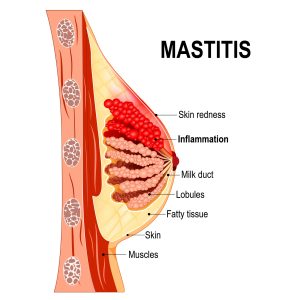Breast Health
How to Treat Breast Inflammatory Conditions

Breast inflammatory conditions, also known as mastitis, is the inflammation of breast tissues due to breastfeeding complications or bacterial infection. Various treatment options are available to manage and relieve symptoms.
Types of Breast Inflammatory Conditions
There are generally two types of breast inflammatory conditions: lactational mastitis and Non lactational mastitis.
Lactational Mastitis
Lactational mastitis is a common breast inflammatory condition that typically occurs during the first few months of breastfeeding. It is more common for first-time mums as they learn how to breastfeed correctly. For example, failure to completely empty the breasts during feedings may result in blocked milk ducts, leading to inflammation.
Infection occurs when bacteria from your baby’s mouth or skin surface enters the milk ducts through cracks in the nipple, resulting in the infection of the breasts. Stagnant milk that is not completely emptied during breastfeeding may further aggravate the infection by providing a breeding ground for the bacteria.

Symptoms
Many people with breast inflammatory conditions (mastitis) will initially notice a red mark on one breast, as it rarely affects both breasts. The affected breast may also be swollen, warm or tender to touch.
Common signs of mastitis may include:
- Breast swelling
- Breast tenderness
- Lump in the breast
- Redness and a burning sensation in the breast area
- Pain
- Fever

Diagnosis
Your breast specialist will perform several tests to diagnose breast inflammatory conditions, including the following:
- A physical examination to detect symptoms of mastitis
- Pus discharge may also be obtained to test for signs of a bacterial infection
If you are not breastfeeding, you may require breast imaging scans to look for breast cancer or other breast conditions such as inflammatory breast cancer – a rare but aggressive form of cancer.
Symptoms of mastitis and inflammatory breast cancer may be similar, hence, it is important to visit a breast specialist for an accurate diagnosis and to provide the appropriate treatment that you need.
Treatments for Breast Inflammatory Conditions
If left untreated, Mastitis (or Mastitis from blocked ducts) can cause a collection of pus (abscess) to develop in your breast, which would require surgical drainage of abscess to treat the condition. To avoid such complications, speak to a breast specialist as soon as you develop signs or symptoms of mastitis. When treatment is sought early, non-surgical methods or home remedies can be used to manage mastitis.
Non-Surgical Treatment
- Antibiotics. If the inflammation is caused by bacterial infection, antibiotic treatment may be used to treat the infection.
- Pain relievers. Your doctor may also recommend over-the-counter anti-inflammatory medications such as ibuprofen or acetaminophen to help with swelling and pain.
Home Remedies
The following self-care tips can also resolve a blocked duct and manage breast inflammatory symptoms:
- Adequate rest
- Drink plenty of water
- Breastfeed and empty your breast milk frequently, especially on the affected side. If this is not possible, use a hand expression or a pump.
- Alternate feeding positions to discover the most effective posture to drain your breastmilk
- Apply cold compress after feeding to relieve pain
- Wear loose-fitting clothes or proper nursing outfits for ease of breastfeeding
Read this next ...
WHO WE ARE
关于SOG
新加坡O&G有限公司(SOG)成立于2011年,我们的愿景是创立一个专业的医疗和外科团队,从而满足现代女性及其孩子和家人的医疗保健需求。我们的诊所遍布新加坡各地,女性和儿童能够方便地享受我们高质量和值得信赖的个性化医疗保健服务。
- 产科
- 妇科
- 妇科肿瘤
- 乳房和普通外科
- 皮肤科
- 儿科
Recommended Specialist
